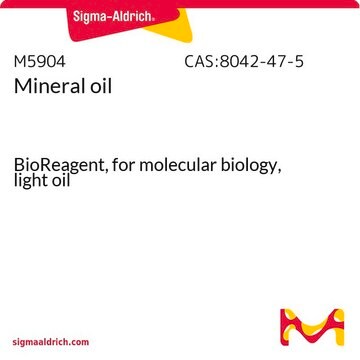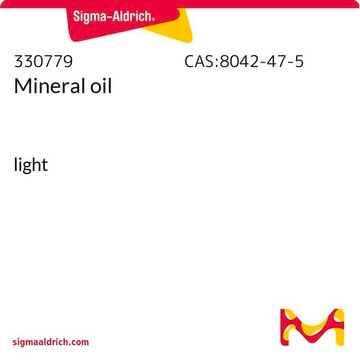110280
Dibutyl ether
ReagentPlus®, ≥99%
Sinónimos:
Butyl ether
About This Item
Productos recomendados
vapor density
4.48 (vs air)
Quality Level
vapor pressure
4.8 mmHg ( 20 °C)
product line
ReagentPlus®
assay
≥99%
form
liquid
autoignition temp.
365 °F
expl. lim.
8.5 %
refractive index
n20/D 1.399 (lit.)
pH
5.2
bp
142-143 °C (lit.)
mp
−98 °C (lit.)
density
0.764 g/mL at 25 °C (lit.)
SMILES string
CCCCOCCCC
InChI
1S/C8H18O/c1-3-5-7-9-8-6-4-2/h3-8H2,1-2H3
InChI key
DURPTKYDGMDSBL-UHFFFAOYSA-N
¿Está buscando productos similares? Visita Guía de comparación de productos
Categorías relacionadas
General description
Application
- To evaluate the anthracene solubility in various binary solvent mixtures composed of dibutyl ether along with n-hexane, cyclohexane, n-heptane, methylcyclohexane, n-octane, isooctane and cyclooctane.
- To measure the pyrene solubility in various binary solvent mixtures composed of dibutyl ether along with n-hexane, cyclohexane, n-heptane, methylcyclohexane, n-octane, isooctane and tert-butylcyclohexane.
- To investigate the reaction mechanism and kinetic studies of the reaction of phenyl isocyanate with methanol in the presence of dibutyltin diacetate (catalyst) to afford urethane. Rate constant of the reaction, k was reported to be 0.96liter/(mole sec).
Legal Information
signalword
Warning
hcodes
Hazard Classifications
Aquatic Chronic 3 - Eye Irrit. 2 - Flam. Liq. 3 - Skin Irrit. 2 - STOT SE 3
target_organs
Respiratory system
Storage Class
3 - Flammable liquids
wgk_germany
WGK 1
flash_point_f
82.4 °F - closed cup
flash_point_c
28 °C - closed cup
Certificados de análisis (COA)
Busque Certificados de análisis (COA) introduciendo el número de lote del producto. Los números de lote se encuentran en la etiqueta del producto después de las palabras «Lot» o «Batch»
¿Ya tiene este producto?
Encuentre la documentación para los productos que ha comprado recientemente en la Biblioteca de documentos.
Nuestro equipo de científicos tiene experiencia en todas las áreas de investigación: Ciencias de la vida, Ciencia de los materiales, Síntesis química, Cromatografía, Analítica y muchas otras.
Póngase en contacto con el Servicio técnico









